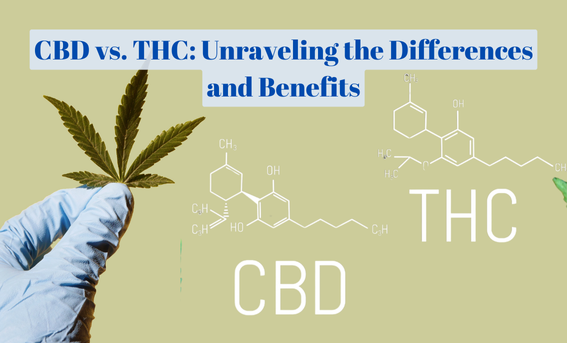1. Introduction
In recent years, CBD (cannabidiol) and THC (tetrahydrocannabinol) have become two of the most talked-about compounds in the cannabis industry. As interest in the therapeutic benefits of cannabis continues to grow, understanding the differences between CBD and THC becomes crucial for consumers and medical professionals alike. Although they come from the same plant, these compounds have distinct effects, uses, and legal statuses.
CBD is often celebrated for its non-psychoactive properties and a wide range of therapeutic applications, while THC is well-known for its psychoactive effects that produce the “high” associated with cannabis. This comprehensive guide will delve into the origins, benefits, side effects, and legal considerations of both CBD and THC, helping you make informed decisions about their use.
By exploring the chemical structures, psychoactive properties, medical benefits, and safety profiles of CBD and THC, we aim to provide a clear and thorough understanding of these two cannabinoids. Whether you are a patient seeking relief, a recreational user, or simply curious about cannabis, this guide will equip you with the knowledge needed to navigate the complex world of CBD and THC.
2. What is CBD?
CBD, or cannabidiol, is one of the many chemical compounds found in the cannabis plant. Unlike its more famous counterpart, THC, CBD is non-psychoactive, meaning it does not produce a “high.” This characteristic makes CBD an attractive option for those looking for relief from various symptoms without the mind-altering effects associated with marijuana use.
Definition and Origin
CBD is a naturally occurring cannabinoid found in both hemp and marijuana plants, which are varieties of Cannabis sativa. It was first isolated in 1940 and has since become a significant focus of research and public interest due to its potential therapeutic benefits. While both hemp and marijuana contain CBD, hemp typically has higher concentrations of CBD and lower levels of THC, making it the preferred source for CBD products.
How CBD Interacts with the Body
CBD interacts with the body through the endocannabinoid system (ECS), a complex cell-signaling system that plays a crucial role in regulating various physiological processes, including mood, pain sensation, appetite, and immune response. The ECS consists of endocannabinoids, receptors (CB1 and CB2), and enzymes that work together to maintain homeostasis.
- CB1 Receptors: Primarily found in the brain and central nervous system, these receptors are involved in functions like memory, mood, and pain perception.
- CB2 Receptors: Mainly located in the peripheral nervous system and immune cells, these receptors play a role in inflammation and immune response.
CBD does not bind directly to CB1 or CB2 receptors but influences them indirectly by enhancing the body’s natural endocannabinoids and interacting with other receptors such as serotonin and vanilloid receptors. This broad interaction profile allows CBD to have a wide range of effects on the body.
Common Uses and Benefits of CBD
CBD has gained popularity for its potential to alleviate various health issues. Some of the most common uses and benefits include:
- Pain Relief: CBD is known for its analgesic properties, making it a popular choice for managing chronic pain conditions such as arthritis and neuropathy.
- Anti-Inflammatory Effects: CBD’s interaction with the ECS and other receptors helps reduce inflammation, which can benefit conditions like inflammatory bowel disease and multiple sclerosis.
- Anxiety and Depression: CBD has shown promise in reducing anxiety and depression by influencing serotonin receptors in the brain, which regulate mood and social behavior.
- Epilepsy and Seizures: One of the most well-documented uses of CBD is in treating epilepsy. The FDA has approved a CBD-based drug, Epidiolex, for treating certain types of seizures.
- Sleep Disorders: CBD may help improve sleep quality by addressing underlying issues such as anxiety, chronic pain, or insomnia.
As research continues, the list of potential benefits of CBD is expected to grow, making it an exciting area of study and application in modern medicine.
3. What is THC?
THC, or tetrahydrocannabinol, is the primary psychoactive compound found in the cannabis plant. It is the chemical responsible for most of marijuana’s psychological effects, including the euphoric “high” that users experience. THC is also recognized for its potential therapeutic benefits, making it a significant focus of both recreational and medical cannabis use.
Definition and Origin
THC is one of over 100 cannabinoids identified in cannabis. It was first isolated in 1964 by Dr. Raphael Mechoulam, an Israeli chemist who is considered one of the pioneers in cannabis research. THC is most abundant in the flowers of the female cannabis plant, particularly in the trichomes, which are tiny, glandular structures that produce and store the plant’s cannabinoids and terpenes.
How THC Interacts with the Body
THC primarily interacts with the endocannabinoid system (ECS), specifically by binding to CB1 receptors, which are predominantly located in the brain and central nervous system. This interaction is what leads to the psychoactive effects associated with THC consumption. THC also binds to CB2 receptors found in the peripheral nervous system and immune cells, contributing to its anti-inflammatory and pain-relieving properties.
- CB1 Receptors: THC’s activation of these receptors is responsible for its psychoactive effects, including altered mood, perception, and cognition.
- CB2 Receptors: While THC’s interaction with these receptors does not produce a high, it plays a role in modulating pain and inflammation.
THC’s ability to mimic the action of anandamide, a naturally occurring endocannabinoid, allows it to influence various physiological processes, including pleasure, memory, thinking, concentration, and coordination.
Common Uses and Benefits of THC
THC is widely used both recreationally and medicinally. Some of the common uses and benefits include:
- Pain Management: THC is effective in alleviating chronic pain, making it a popular choice for patients suffering from conditions like fibromyalgia, arthritis, and multiple sclerosis.
- Appetite Stimulation: Known colloquially as “the munchies,” THC can stimulate appetite, which is beneficial for individuals with conditions such as HIV/AIDS or cancer that cause significant weight loss.
- Nausea and Vomiting: THC has antiemetic properties, making it effective in reducing nausea and vomiting, especially in patients undergoing chemotherapy.
- Muscle Spasticity: THC can help reduce muscle spasticity and cramps, particularly in conditions like multiple sclerosis.
- Sleep Aid: THC can help with sleep disorders by reducing the time it takes to fall asleep and increasing overall sleep duration.
While THC offers various therapeutic benefits, it is essential to use it responsibly due to its psychoactive nature and potential side effects, such as impaired memory, altered judgment, and coordination issues. Understanding the appropriate dosages and consumption methods can help mitigate these risks and enhance the therapeutic experience.
4. Key Differences Between CBD and THC
Understanding the key differences between CBD and THC is essential for anyone considering their use, whether for medical or recreational purposes. Although both are cannabinoids found in the cannabis plant, their effects on the body and mind are quite distinct.
Chemical Structure
CBD and THC have the same molecular formula: C21H30O2. However, their atoms are arranged differently, leading to significant differences in their effects. This difference in structure allows THC to bind directly to CB1 receptors in the brain, while CBD interacts with the endocannabinoid system in a more indirect manner.
- CBD: C21H30O2
- THC: C21H30O2
Psychoactive Properties
One of the most notable differences between CBD and THC is their psychoactive properties.
- THC: THC is psychoactive and is the primary compound responsible for the “high” associated with marijuana use. It activates CB1 receptors in the brain, leading to altered perception, mood, and cognition.
- CBD: CBD is non-psychoactive, meaning it does not produce a high. It can even counteract the psychoactive effects of THC when both are present in the body.
Medical Benefits
Both CBD and THC have been found to offer a range of therapeutic benefits, but they are often used to treat different conditions.
- CBD:
- Pain Relief: Effective for chronic pain and inflammation.
- Anxiety and Depression: Known to reduce symptoms of anxiety and depression.
- Seizures: FDA-approved for treating certain types of epilepsy.
- Neuroprotective: Potentially beneficial for neurodegenerative disorders.
- THC:
- Pain Management: Helps in reducing pain, particularly neuropathic pain.
- Appetite Stimulation: Increases appetite in patients with severe weight loss.
- Nausea and Vomiting: Effective in treating nausea, especially in chemotherapy patients.
- Muscle Spasticity: Reduces muscle spasms and stiffness.
Potential Side Effects
The side effects of CBD and THC also differ significantly.
- CBD:
- Generally well-tolerated with few side effects.
- Possible side effects include fatigue, changes in appetite, and diarrhea.
- No psychoactive effects.
- THC:
- Can cause psychoactive effects such as paranoia, anxiety, and impaired memory.
- Other side effects include dry mouth, red eyes, and increased heart rate.
- Potential for dependency and misuse.
Legality
The legal status of CBD and THC varies widely across different regions and countries.
- CBD:
- Legal in many countries and states, especially when derived from hemp with less than 0.3% THC.
- Approved by the FDA for certain medical conditions (e.g., Epidiolex for epilepsy).
- THC:
- Legal in some regions for medical or recreational use, but remains illegal under federal law in many countries, including the United States.
- Legal status often depends on the concentration of THC in the product.
Drug Testing
Both CBD and THC can show up on drug tests, but the implications are different.
- CBD:
- Pure CBD products should not cause a positive result on a drug test.
- Contamination with THC can lead to positive tests, so it’s crucial to choose high-quality products.
- THC:
- THC is the primary compound tested for in drug screenings.
- Regular or high-dose use can lead to positive test results for weeks after consumption.
Understanding these key differences can help individuals make informed decisions about the use of CBD and THC, ensuring they choose the right compound for their specific needs and circumstances.
5. Synergistic Effects: THC, CBD, and the Entourage Effect
The relationship between CBD and THC goes beyond their individual effects. When used together, these cannabinoids can interact in ways that enhance their therapeutic benefits, a phenomenon known as the entourage effect. This concept suggests that the combined effect of all the cannabinoids, terpenes, and other compounds in the cannabis plant is greater than the sum of their individual effects.
The Entourage Effect Explained
The entourage effect was first proposed by researchers Raphael Mechoulam and Shimon Ben-Shabat in 1999. It posits that cannabinoids and other compounds in cannabis work synergistically to produce more profound therapeutic effects than any single compound could achieve alone. This synergy can enhance the efficacy of the cannabinoids and mitigate potential side effects.
- Cannabinoids: Besides THC and CBD, the cannabis plant contains over 100 other cannabinoids, including CBG (cannabigerol) and CBC (cannabichromene), each contributing to the overall effect.
- Terpenes: These aromatic compounds give cannabis its distinct smell and flavor. Terpenes like myrcene, limonene, and pinene also have their own therapeutic properties and can interact with cannabinoids to enhance their effects.
How THC and CBD Work Together
When THC and CBD are consumed together, they can influence each other’s effects in various ways:
- Mitigating Psychoactivity: CBD can reduce the psychoactive effects of THC, making the experience more tolerable for those who are sensitive to THC. This is particularly beneficial for patients who need the therapeutic benefits of THC without the intense high.
- Enhanced Pain Relief: Studies have shown that the combination of THC and CBD can provide more effective pain relief than either compound alone. This is due to their complementary mechanisms of action in the body.
- Improved Therapeutic Outcomes: The combination of THC and CBD has been found to be more effective in treating conditions like epilepsy, multiple sclerosis, and chronic pain. For example, Sativex, a pharmaceutical drug containing both THC and CBD, is used to treat muscle spasticity in multiple sclerosis patients.
Choosing Products for the Entourage Effect
When seeking the benefits of the entourage effect, it’s important to choose full-spectrum or broad-spectrum cannabis products:
- Full-Spectrum Products: These contain all the cannabinoids, terpenes, and other compounds found in the cannabis plant, including trace amounts of THC (below 0.3% if derived from hemp). This allows users to experience the full entourage effect.
- Broad-Spectrum Products: These also contain multiple cannabinoids and terpenes but have all traces of THC removed. While they still offer some level of the entourage effect, the absence of THC means they might be less potent in certain therapeutic applications.
Understanding Ratios and Dosing
The ratio of THC to CBD in a product can significantly influence its effects. Common ratios include:
- 1:1 Ratio: Equal parts THC and CBD, offering a balanced effect that provides pain relief and mild psychoactivity.
- High CBD, Low THC (e.g., 20:1): Primarily for those seeking the benefits of CBD with minimal psychoactive effects.
- High THC, Low CBD (e.g., 1:20): More psychoactive, suitable for conditions that respond better to higher THC levels.
It’s crucial to start with low doses and gradually increase to find the optimal balance for individual needs. Consulting with a healthcare professional experienced in cannabis therapy can also help determine the best approach for leveraging the entourage effect.
By understanding and utilizing the entourage effect, users can maximize the therapeutic potential of CBD and THC, leading to more effective and well-rounded treatment options.
6. Similarities Between CBD and THC
While CBD and THC have many differences, they also share several similarities. Understanding these commonalities can help provide a more comprehensive view of how these cannabinoids interact with the body and their potential benefits.
Potential Benefits
Both CBD and THC have been studied extensively for their potential health benefits. Despite their differing effects, they can sometimes offer similar therapeutic outcomes.
- Pain Relief: Both CBD and THC are effective in managing different types of pain, including chronic pain, neuropathic pain, and inflammation-related pain. They interact with the body’s endocannabinoid system to modulate pain signals and provide relief.
- Anti-Inflammatory Properties: CBD and THC both exhibit anti-inflammatory properties, which can be beneficial for conditions such as arthritis, inflammatory bowel disease, and other chronic inflammatory conditions.
- Neuroprotective Effects: Research suggests that both cannabinoids have neuroprotective properties, meaning they can help protect the nervous system from damage and may be beneficial in treating neurodegenerative diseases like Alzheimer’s, Parkinson’s, and multiple sclerosis.
- Antiemetic Effects: Both CBD and THC can reduce nausea and vomiting, which is particularly useful for patients undergoing chemotherapy or those with conditions like HIV/AIDS.
- Sleep Aid: Both cannabinoids can help improve sleep quality. THC is known for its sedative effects, while CBD can help with underlying issues such as anxiety and chronic pain that might interfere with sleep.
Ingestion Methods
CBD and THC can be consumed in a variety of ways, offering flexibility for users based on their preferences and needs. Some common ingestion methods include:
- Smoking and Vaping: Inhalation provides rapid onset of effects as the cannabinoids are quickly absorbed into the bloodstream through the lungs. This method is often preferred for immediate relief.
- Edibles: Ingesting CBD or THC through foods and beverages provides a longer-lasting effect, though it takes longer for the effects to be felt as the cannabinoids are processed through the digestive system.
- Tinctures and Oils: These liquid extracts can be taken sublingually (under the tongue) for quick absorption or added to food and drinks. They offer precise dosing and a relatively fast onset of effects.
- Topicals: Lotions, balms, and creams infused with CBD or THC can be applied directly to the skin to target localized pain, inflammation, or skin conditions without producing psychoactive effects.
- Capsules and Pills: These provide a convenient and consistent dosage, making them a popular choice for those using cannabinoids for chronic conditions.
Safety Profiles
Both CBD and THC are generally considered safe, but they can cause different side effects:
- CBD:
- Generally well-tolerated with few side effects.
- Possible side effects include fatigue, diarrhea, and changes in appetite and weight.
- No psychoactive effects and low potential for abuse.
- THC:
- Can cause psychoactive effects such as euphoria, altered perception, and impaired coordination.
- Potential side effects include anxiety, paranoia, dry mouth, red eyes, and increased heart rate.
- Higher potential for dependency and abuse, particularly with heavy or prolonged use.
Understanding these similarities can help users make informed decisions about how to incorporate CBD and THC into their wellness routines, maximizing benefits while minimizing risks.
7. CBD vs. THC: Choosing the Right Cannabis Product
Selecting the appropriate cannabis product involves understanding the differences between CBD and THC, as well as considering your personal goals and health conditions. Here’s a guide to help you make an informed choice.
Factors to Consider When Choosing Between CBD and THC
- Desired Effects:
- CBD: Choose CBD if you are looking for therapeutic benefits without the psychoactive effects. It is ideal for managing anxiety, chronic pain, inflammation, and epilepsy.
- THC: Opt for THC if you need stronger pain relief, appetite stimulation, or help with sleep. THC is also more effective for conditions that respond well to its psychoactive properties.
- Tolerance and Sensitivity:
- CBD: Suitable for individuals sensitive to THC or those who prefer not to experience a high.
- THC: May cause psychoactive effects that not everyone tolerates well. Start with low doses to gauge your sensitivity.
- Legal Considerations:
- CBD: Generally legal in many regions, especially if derived from hemp with less than 0.3% THC. Always check local regulations.
- THC: Legal status varies widely. Some areas allow recreational use, others only for medical use, and in some places, it is still illegal.
- Purpose and Condition:
- Medical Use: Consult with a healthcare professional to determine the best cannabinoid and dosage for your specific condition.
- Recreational Use: Consider the setting and your comfort level with the psychoactive effects of THC.
Personal Goals and Health Conditions
- Pain Management:
- CBD: Effective for mild to moderate pain and inflammation.
- THC: Better suited for severe or chronic pain, including neuropathic pain.
- Mental Health:
- CBD: Helps with anxiety, depression, and PTSD without causing a high.
- THC: Can help with anxiety and mood disorders but may exacerbate symptoms in some individuals.
- Sleep Disorders:
- CBD: Can improve sleep quality by addressing underlying issues such as anxiety or pain.
- THC: Induces sleep more directly, making it useful for insomnia.
- Neurological Conditions:
- CBD: FDA-approved for certain types of epilepsy and shows promise for neurodegenerative diseases.
- THC: Provides relief for symptoms of multiple sclerosis and other neurodegenerative conditions.
- Appetite and Nausea:
- CBD: May help with nausea but is less effective for appetite stimulation.
- THC: Known for its ability to reduce nausea and increase appetite, making it beneficial for chemotherapy patients and those with wasting syndromes.
Consulting with Healthcare Professionals
Before starting any cannabis product, it’s important to consult with a healthcare professional, especially if you have pre-existing conditions or are taking other medications. A professional can help determine the most appropriate cannabinoid, dosage, and delivery method for your needs.
- Medical Marijuana Clinics: These clinics specialize in cannabis treatments and can provide personalized recommendations based on your medical history.
- Primary Care Physicians: Your regular doctor can offer advice and monitor your progress, ensuring cannabis use does not interfere with other treatments.
Product Types and Quality
When choosing cannabis products, consider the following:
- Full-Spectrum vs. Isolate:
- Full-Spectrum: Contains all cannabinoids and terpenes, providing the entourage effect.
- Isolate: Contains only CBD or THC, with no other cannabinoids or terpenes.
- Source and Purity:
- Ensure products are sourced from reputable growers and manufacturers.
- Look for third-party lab testing to verify purity and potency.
- Delivery Methods:
- Inhalation (smoking or vaping): Quick onset of effects.
- Ingestion (edibles, capsules): Longer-lasting effects.
- Topicals: Targeted relief for localized pain or skin conditions.
- Tinctures and Oils: Flexible dosing and quick absorption.
Both CBD and THC are two of the most well-known and widely studied cannabinoids found in the cannabis plant. While they share some similarities, their differences are significant and can influence which one might be more suitable for an individual’s needs. By understanding your needs and the properties of CBD and THC, you can choose the right cannabis product to achieve your desired outcomes.
To know more about UZIO Payroll/HR solution for the cannabis industry and get in touch with us for an expert-led demo.















